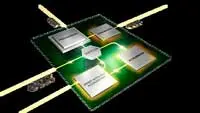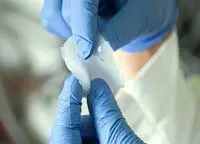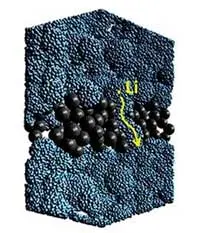Electronics News
Archive : 12 September 2017 год
 Xilinx, Arm, Cadence Design Systems and TSMC are collaborating to build the first Cache Coherent Interconnect for Accelerators (CCIX) test chip with TSMC 7nm FinFET process technology for delivery in 2018.
Xilinx, Arm, Cadence Design Systems and TSMC are collaborating to build the first Cache Coherent Interconnect for Accelerators (CCIX) test chip with TSMC 7nm FinFET process technology for delivery in 2018.
The test chip will be implemented on TSMC’s 7nm process and be based on the latest Arm DynamIQ technology, CMN-600 coherent on-chip bus and foundation IP.
According to those companies involved in the collaboration CCIX leverages existing server interconnect infrastructure and is able to deliver higher bandwidth, lower latency and cache coherent access to shared memory delivering a significant improvement in the usability of accelerators and the overall performance and efficiency of data centre platforms, lowering the barrier to entry into existing server systems and improving the total cost of ownership (TCO) of acceleration systems.
Applications such as big data analytics, search, machine learning, wireless 4G/5G, in-memory database processing, video analytics, and network processing benefit from acceleration engines that enable data to be moved seamlessly among various system components.
CCIX will allow components to access and process data irrespective of where it resides, without the need for complex programming environments.
“With the surge in artificial intelligence and big data, we’re seeing increasing demand for more heterogeneous compute across more applications,” said Noel Hurley, vice president and general manager, Infrastructure Group, Arm. “The test chip will not only demonstrate how the latest Arm technology with coherent multichip accelerators can scale across the data centre, but reinforces our commitment to solving the challenge of accessing data quickly and easily. This innovative and collaborative approach to coherent memory is a significant step forward in delivering high-performance, efficient data centre platforms.”
Author
Neil Tyler
Source: www.newelectronics.co.uk
 The US Army Research Laboratory (ARL), working with the University of Maryland, has developed a lithium-ion battery that uses a water-salt solution as its electrolyte and says it could be commercialised within five years.
The US Army Research Laboratory (ARL), working with the University of Maryland, has developed a lithium-ion battery that uses a water-salt solution as its electrolyte and says it could be commercialised within five years.
According to the team, its battery provides 4V without the risks associated with non-aqueous lithium-ion batteries. Dr Kang Xu, an ARL fellow, noted: “In the past, if you wanted high energy, you would choose a non-aqueous lithium-ion battery, but would have to compromise on safety. If you preferred safety, you could use an aqueous battery such as nickel/metal hydride, but you would have to settle for lower energy. Now, we are showing that you can have access to high energy and high safety.”
The work builds on previous research which developed a similar 3V battery with an aqueous electrolyte. The leap from 3V to 4V, was enabled by University of Maryland (U of M) researcher Chongyin Yang, who designed a gel polymer electrolyte coating that can be applied to the graphite or lithium anode.
This hydrophobic coating expels water from the vicinity of the electrode surface and then, upon charging for the first time, decomposes and forms a stable interphase that separates the solid anode from the liquid electrolyte. This allows desirable materials, such as graphite or lithium metal, to be used, while bringing better energy density and cycling ability.
The team says that, although the power and energy density of its new battery are suitable for commercial applications, improvements would make it even more competitive. In particular, the researchers are looking to increase the number of full-performance cycles the battery can complete and to reduce material expenses. “Right now, we are talking about 50 to 100 cycles,” said U of M’s Professor Chunsheng Wang, “but to compare with organic electrolyte batteries, we want to get to 500 or more.”
Dr Xu pointed to the importance of what he called ‘electrochemical manipulations’ in battery technology. “This is the first time that we have been able to stabilise really reactive anodes like graphite and lithium in aqueous media. This opens a broad window into many different topics in electrochemistry, including sodium-ion and lithium-sulphur batteries, multiple ion chemistries involving zinc and magnesium, or even electroplating and electrochemical synthesis; we just have not fully explored them yet.”
Author
Graham Pitcher
Source: www.newelectronics.co.uk
 Researchers at the Okinawa Institute of Science and Technology are the latest to publish work exploring the use of silicon anodes in lithium-ion batteries.
Researchers at the Okinawa Institute of Science and Technology are the latest to publish work exploring the use of silicon anodes in lithium-ion batteries.
In its work, the team has designed an anode featuring nanostructured layers of silicon. Said to resemble a multi-layered cake, the construction is claimed to retain the advantages of a silicon anode while preventing its physical collapse.
The problem is that while an atom of silicon can bind four atoms of lithium, accommodating those atoms means the volume of a silicon anode swells significantly, leading to fracturing and loss of structural integrity.
In its approach, the team deposited alternate layers of unstructured silicon films and tantalum metal nanoparticle scaffolds. The result sees silicon sandwiched in a tantalum frame.
“We used cluster beam deposition,” said researcher Dr Marta Haro Remon. “The required materials are deposited on the surface with great control. This is a purely physical method; there is no need for chemicals, catalysts or other binders.”
The work, led by Professor Mukhles Sowwan, is an anode with higher power, restrained swelling and excellent cyclability. The silicon anode has a porosity that allows lithium ions to travel at higher speeds, while silicon channels in the tantalum scaffold allows lithium ions to diffuse through the structure.
The silicon anode is also helping to improve the ability to charge the battery and deliver energy. “The goal in battery technology right now is to increase charging speed and power output,” said Dr Haro Remon. “While it is fine to charge your phone or your laptop over a long period of time, you would not wait by your electric car for three hours at the charging station.”
Author
Graham Pitcher
Source: www.newelectronics.co.uk
